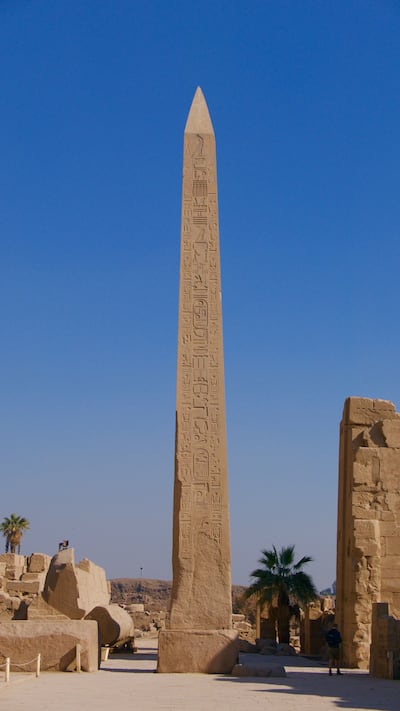Egyptian archaeologists have, after extensive restoration efforts, re-erected the top part of one of two obelisks dedicated to Queen Hatshepsut at Luxor’s famed Karnak Temple.
Built in 1457 BC, the obelisk, which had collapsed following an earthquake in antiquity, was re-erected in its original location on Saturday night, said a statement from the antiquities ministry.
One of two obelisks bearing the name of the ancient queen at Karnak, it was carved out of one single slab of pink granite. The upper part of the obelisk, the only intact fragment of it following the earthquake, weighs 90 tonnes and is 11 metres tall.
The top part had been moved from its original location in the early 20th century by French Egyptologist Georges Lagrain to make way for the large-scale excavations taking place in Karnak at the time.
It was then laid down on its side by Legrain’s team beside Karnak’s artificial sacred lake, one of the main attractions of the famed temple.

The decision to re-erect the obelisk in its original location came after researchers from Egypt’s Supreme Council of Antiquities determined that it was under threat of further damage, said the antiquities ministry’s statement.
Hatshepsut’s other obelisk is still standing in Karnak, measuring around 30 metres in length and weighing 343 tonnes. It is currently the tallest standing obelisk in Egypt.

Because of the size and value of the fallen obelisk, the ministry co-operated with the Engineering Authority of the Armed Forces which provided the necessary equipment to carry out the task safely.
Carved on the sides of the re-erected obelisk are scenes depicting Hatshepsut, ancient Egypt’s second confirmed female pharaoh, and her relationship with the god Amun, one of the most important deities of the New Kingdom.
Hatshepsut was famously devout, having donated a great deal of funds to the priests of Amun, an influential religious group in ancient Egypt, who in turn offered her the necessary support to ascend to the Egyptian throne over her stepson Thutmose III who would lead an uprising against her upon reaching adulthood.

The fallen obelisk is believed by most Egyptologists to have also been 30 metres tall before it was brought down by the earthquake. Fragments of the original structure are said to have been sold to various foreign museums, including the Museum of Fine Arts in Boston, US, and the Nicholson Museum in The University of Sydney, Australia.
Its re-erection is one of a number of restoration projects being carried out at Luxor’s varied pharaonic sites, in a bid to drum up more tourism to the Nile-side city.
Last year, the ministry inaugurated the Avenue of the Sphinxes, a processional road that connects two of the city’s most prominent temples, Karnak and Luxor.


